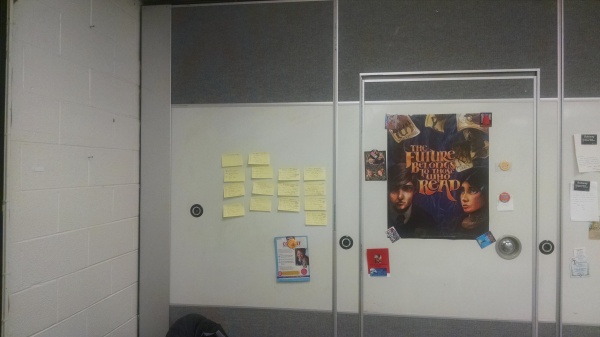One of the most difficult parts of setting up a workshop was figuring out how to use and organize notes. Those videos that show elementary school teachers walking around at leisure, seeming to write a paragraph on each child? Not even possible, not even under the best circumstances.

Wall space can also be temporary storage for conference notes and for giving you a “status of the class” picture of student progress.
What follows is a step-by-step guide to How I Workshop.
- Figure out what you, as a teacher, are out to accomplish. Are you trying to do a quick check in with each student, or are you going to do extensive work with 2-3 kids? You need both kinds of conferring styles, I’d argue, but you also know which mode you are using, when, and why.
- Write down 1-2 words in conference, add notes later if you need to. When I sweep and chat to each student, as I did today, I’ll scribble in a few more notes after class if I need to.
- Notice patterns. I like using my post-it notes to “snapshot” where students as a whole are and where I need to teach something the following day, especially if I find myself repeating myself over and over again in conferences.
- Diagnose and select students for extended follow up. If I notice that a student is working on an issue that involves more conversation, I’ll prioritize them for the next day.
- Save and document information. I can pop these post-it notes into a plan book.
How do you manage your conference notes?
Amy Estersohn is a middle school English teacher in New York. She never met a Post-It Note she didn’t like.
Tagged: Readers Writers Workshop

[…] Once again, Three Teachers Talk come up with a comprehensive list of how to give feedback in a timel… The value of using Canvas cannot be overstated. Being able to communicate with each student with feedback makes this important practice easier and in real-time. One drawback is, however, that big, visible space that students are doing things–if evaluators can’t see it, they often don’t recognize or realize, or even respect, that it is happening. […]
LikeLike
Great info! Cris Tovani offers much insight into this extremely valuable connection!
LikeLike